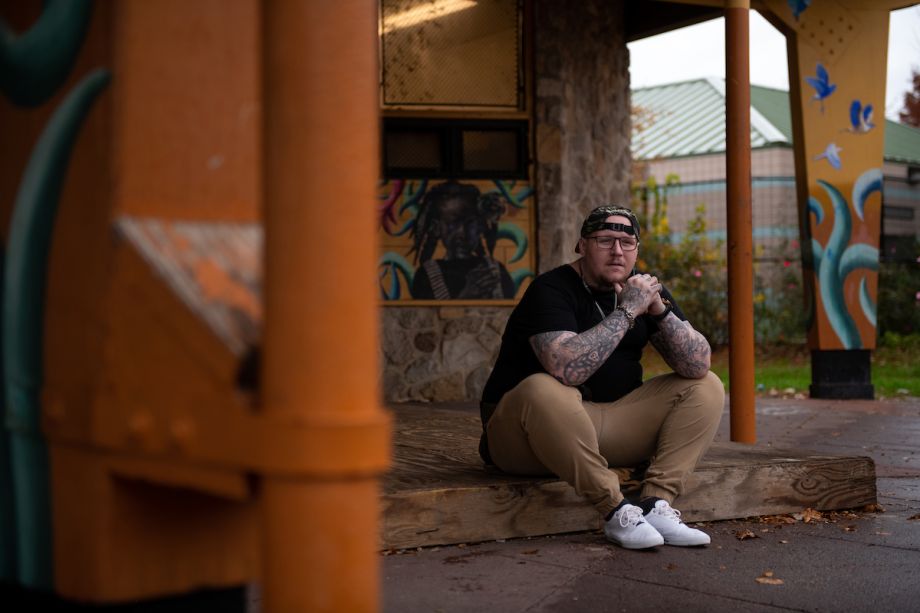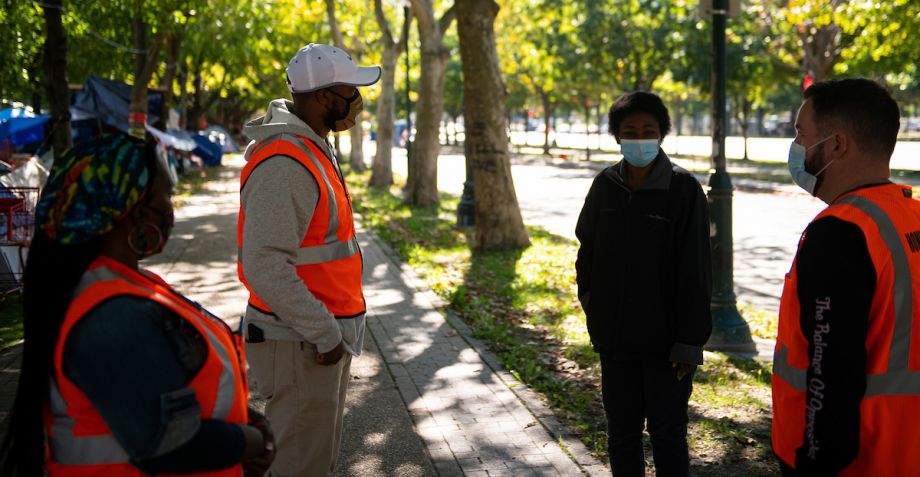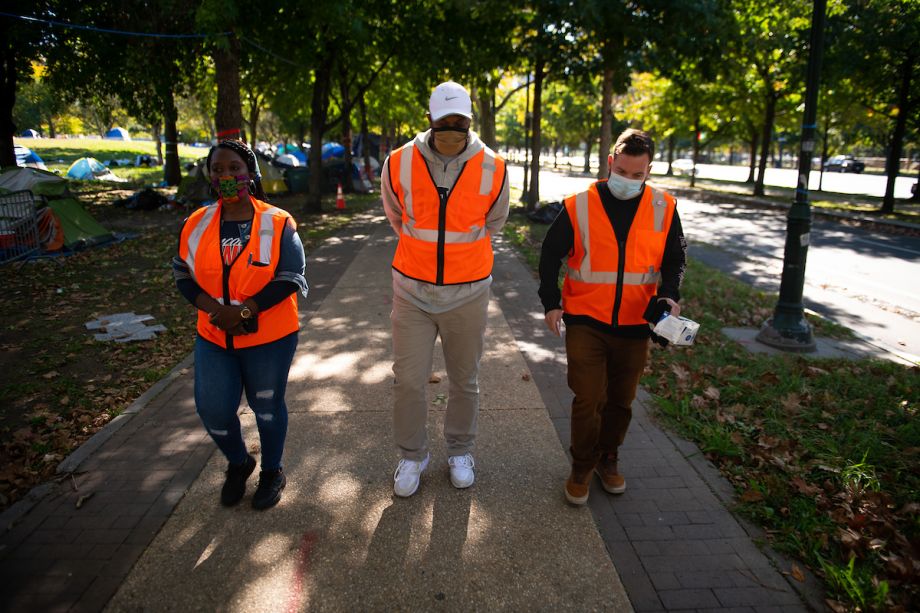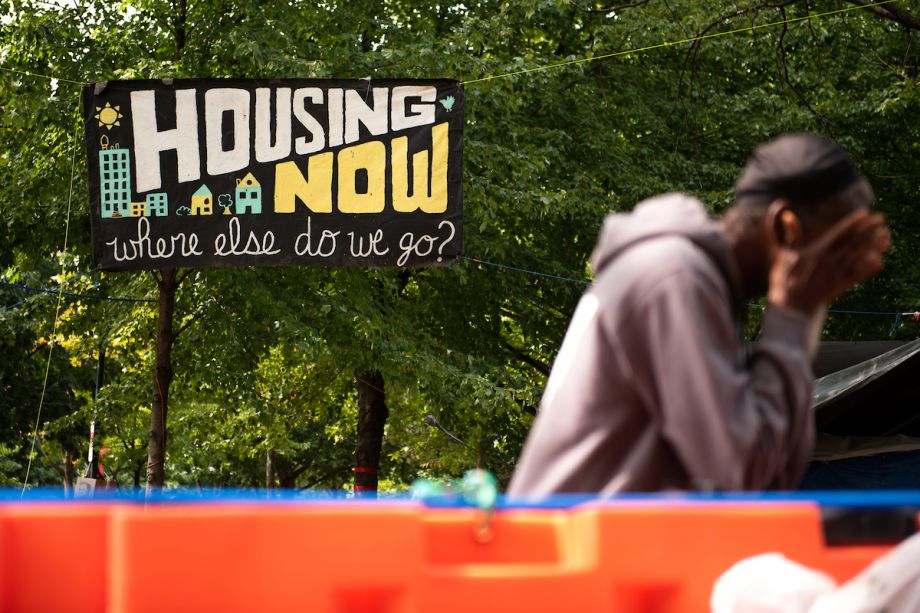Are You A Vanguard? Applications Now Open
Philadelphia Project HOME Outreach Workers Edward Dover, left, and Amy Abrahms-Beverly, center, talk with Danielle Hunter, right, a resident of the encampment along the Benjamin Franklin Parkway.
This is your first of three free stories this month. Become a free or sustaining member to read unlimited articles, webinars and ebooks.
Become A MemberEDITOR’S NOTE: This story is part of a series called “Zig Zag: The Winding Path to Making Ends Meet in Philadelphia,” which focuses on how improving one facet of a person’s life — from housing, to education, to business — can establish a stable foundation for economic mobility. The series is produced with support from Broke in Philly, a collaborative reporting project on solutions to poverty and the city’s push toward economic mobility. Next City is one of more than 20 news organizations producing Broke in Philly. Follow us on Twitter @BrokeInPhilly.
Rocky, 32, a South Philadelphia native, fell into fentanyl addiction after a series of traumatic events that left him scarred with PTSD: In 2014, he lost the love of his longtime girlfriend; his cousin, who was more like a brother, died a tragic death that Rocky still can’t bring himself to talk about; and his brother went to prison.

“I kept on getting worse and worse with the drugs because I was trying to numb the pain,” Rocky says.
He wound up homeless, sleeping on his parents’ porch for a month before crashing on park benches and eventually finding his way to the “tubes” in South Philadelphia — enormous steel pipes stacked one atop another like logs at an abandoned construction site. He was starting to get “comfortable,” Rocky says, having his fentanyl delivered, sitting on a couch inside his hideout.
But then he met Edward Dover, known simply as “Dover” to friends and colleagues, the lead outreach worker for Project HOME, one of the Philadelphia organizations that tries to connect those experiencing homelessness with housing and other services, such as rehab.
“He asked me if I needed anything,” Rocky recalls. “I told him, ‘Yeah! I could use some boots and some clothes maybe.’ The next day he came with a nice pair of boots because it was wintertime, and I had holes in the bottom of my boots. I was getting my feet soaking wet every day. He kept in contact all the time.”
The minute Rocky was ready to get help, Dover found him a bed at Kirkbride Center, a behavioral health care facility in Philadelphia. When it proved to be a bad fit, Dover got Rocky into another treatment center, Journey of Hope in North Philadelphia.
“I say it all the time that I could not be where I am right now if it wasn’t for Dover,” Rocky says, on his 205th day sober.
Pretty soon, Rocky will be eligible for an apartment through the Journey of Hope program and is applying for disability because of his PTSD. As an extraordinary outreach worker by all accounts, Dover had the compassion and tools that Rocky needed at just the right time.
“People need to understand that they shouldn’t judge homeless people,” Rocky says. “They don’t know their past. They don’t know what happened to them that led to them being homeless.”
Plus, Rocky says, Dover understands that many people don’t — that substance use disorder is a disease.
“When I was battling drugs, I used to say, ‘I wish I could change places with someone so that someone could feel the pain that I do for one day.’ … just so they understand and kinda feel for us,” Rocky reflects.
Dover not only understands, he takes action to help combat the escalating problem with homelessness in the United States — especially since COVID-19 hit.
According to the United States Department of Housing and Urban Development, 17 out of every 10,000 people in this country experience homelessness on any given night, according to HUD’s 2019 Annual Point-in-Time Count. HUD stresses that “these 567,715 people represent a cross-section of America” — that they are “associated with every region of the country, family status, gender category and racial/ethnic group.”

Rocky at Mander Playground, in Fairmont Park. With Dover's assistance, he will soon be eligible for an apartment through the Journey of Hope program.
Permanent supportive housing, an intervention that combines affordable housing with social support services, currently represents 41.8 percent of all homeless assistance beds, according to HUD, though these numbers are based on 2017 counts. Emergency shelters are next, representing nearly 33 percent of homeless assistance beds. Rapid rehousing, in which unsheltered individuals move directly from the street into permanent housing, is a newer program that accounts for more than one in 10 beds nationally — a 372 percent increase from 2013 to 2017, according to HUD.
Liz Hersh, director of Philadelphia’s Office of Homeless Services, says that one of the things that “plagues” outreach workers is that “people don’t believe homelessness is solvable.” That’s a myth; she says she and others in the field have seen “over and over again that when we are able to give people what they need, they don’t want to be homeless.”
Outreach workers such as Dover are the connective tissue between people on the street and finding placements. Research shows that helping unsheltered individuals find permanent housing can be the catalyst that turns their lives around. Those who work with people experiencing homelessness say that making these matches is not easy under normal circumstances and has been made exponentially more difficult by COVID-19. Not only have outreach workers been having to worry about those living on the street being unsheltered and at risk of contracting coronavirus, but they have also been concerned about keeping themselves healthy, retrofitting shelters and other sites to meet CDC guidelines, and educating people about the dangers the virus poses. To fully grasp the empathy and relationship-building necessary to transition people experiencing homelessness into permanent housing, it helps to understand more about Dover himself.
Early on in his 15-plus-year outreach career, Dover learned an important lesson: not promising more than he can deliver.
“That’s one of the first mistakes I made is you can’t promise anybody because they’ll hold you to it, and if you don’t deliver, they won’t mess with you anymore,” Dover says. “That person will spread the word to everybody else what you did, and [then] that next person won’t deal with you. And it will trickle all the way down until you [think] , ‘Damn. I don’t even know why I’m doing this anymore. Ain’t nobody trust me.’ That’s the one mistake I made.”
Tim Sheahan, director of homeless services for Philadelphia’s Department of Behavioral Health and Intellectual disAbility Services, says, “As our commissioner [David T. Jones] who just left said, ‘Under-promise and over-deliver.’”
His early learning curve aside, Dover has used this approach well as he has helped place people in secure housing during the closing of encampments around the city, including most recently the one on Benjamin Franklin Parkway, which supported between 175 and 220 unsheltered people at its peak. He also visits the nooks and crannies around town where he knows people experiencing homelessness hang out. Dover uses compassion and remains persistent in his outreach work, but tries not to push too hard.
“If you push, you can’t build a relationship,” Dover says. “If you are pushing and pushing, they’re never going to talk to you.”
Fostering relationships is the goal, Dover says.
“I try not to be a nuisance to [the clients] and come up to them with the same information every day,” Dover says. “I try to change the subject up — you know — talk about different things to build a relationship with them. That’s the whole point of what a person doing outreach does. After I get the relationship with them, it makes my job easier, especially trying to meet their needs.”
One of Dover’s tricks? He uses a cigarette to draw people out.
“It’s amazing the kind of conversation you get from a cigarette,” Dover says. “They talk to you through the tent. As soon as you offer them a cigarette, they come out of the tent — so if I never offered that cigarette, they’d still be talking to [me] through the tent. So I’m, ‘You like a cigarette?’ He’s like, ‘Yeah, yeah. Sure. Let me put my pants on.’ And they talk to you to find out what we do.”
“Our big thing is you live a longer life when you’re housed,” Sheahan says. “Often, no, it’s not immediately permanent housing.” It may be a safe haven or a shelter. “But it gets you in the [system], and eventually it leads to a housing match. And folks move along that continuum.
In fiscal year 2020, 82 percent of those who left an emergency shelter, safe haven, or transitional housing project did not return to homelessness, according to Philadelphia’s Office of Homeless Services FY 2020 Data Snapshot. The goal is to make homelessness non-recurring, according to the report, and the numbers seem to support that individuals who enter the temporary housing system have a higher chance of becoming permanently housed.
Adjusting to the pandemic made existing challenges steeper. “It was really a very seismic system change overnight,” says Hersh.
Since the beginning of COVID-19, many of the day programs for unsheltered people have shuttered. The focus has been on getting food and other basic necessities out to people on the street. Outreach workers have been educating individuals about sanitation and social distancing, and guiding people to handwashing stations and portable restrooms that the city has set up in different neighborhoods, Sheahan said.
In addition, the city had to de-densify every shelter to move beds at least six feet apart and install bed barriers.
“Remember, early in the pandemic, there was no PPE [personal protective equipment], so trying to get even hand soap and hand sanitizer and trash cans and Kleenex and, god forbid, masks … I don’t think it was practically until May that we had enough masks for everybody,” Hersh says. “[We were] trying to keep beds open so that people could come in and be safe.”
She continues, “We had been spending the last several years making it easier to come in, and suddenly our staff had to be all masked up and take people’s temperatures and ask people personal questions like, ‘How do you feel today? Do you have any respiratory symptoms?’ before even talking to them.”

The point of outreach work is to make a connection with unsheltered individuals, says Edward Dover, second from left. “After I get the relationship with them, it makes my job easier, especially trying to meet their needs.”
The city negotiated with several hotels to set up a quarantine site for unsheltered individuals who had contracted COVID-19, as well as two prevention sites to get those at high-risk and elderly folks out of congregate settings where there might be outbreaks. In addition, the city had to look out for its own workers, Hersh says.
“Just like healthcare workers, our people are essential workers, and they all have children at home whose lives have been disrupted, or aging parents who were very vulnerable themselves,” Hersh says. “But [the outreach workers] were still coming to work every day. So we had to keep them safe, and there was a lack of information about the virus and how it spread, so it was really working with them and supporting them and answering all of their questions and trying to offer all that information so they could continue to do their jobs.”
Dover has not let fears about contracting COVID-19 disturb him. He wears a mask and frequently sanitizes his hands. His wife FaceTimes him several times a day to make sure he is doing so, he says with a laugh.
“You won’t be able to focus on doing your job if you worry about it,” he says. “It’s tough, and it’s definitely scary doing what I do. But, you know, somebody’s got to do it, and I’m that person.”
Dover said his father always taught him to finish what he started, so that is a rule he lives by. As one of nine siblings growing up in South Philadelphia, Dover learned his work ethic early. In order to buy the sneakers he wanted, he landed his first job detailing cars at 13.
“I’ve been working ever since,” says Dover, who, in addition to his outreach, has a second job transporting individuals from Project HOME’s after-hours intake center for men to a shelter in Southwest Philadelphia. He works 11 to 12 hours a day before going home to his wife and four children, the oldest of whom attends Bloomsburg University of Pennsylvania.
As a child, Dover would look for odd jobs around the neighborhood, such as shoveling snow. He spent years scooping ice cream at what is now called the Wachovia Center, a job he says kept him off the corners where so many of his peers were dealing drugs. In addition, he graduated from high school and simultaneously completed Job Corps training in building maintenance.
“I was what they would say in my neighborhood a ‘go-getter,’” Dover says. “I knew I couldn’t get [money] from my parents. I didn’t want to go the illegal way, so I tried to find a positive way.”
At 19, Dover got his first job working in a city shelter. At first it felt “weird” and a little “scary.” But he soon developed deep respect for the people he was trying to help.
“I’ve seen too much as far as staff, how they treat clients,” Dover says. “You don’t treat them like they’re nothing. They are still human beings. They’re not dogs… You could be them on any given day. You treat them how you would treat yourself, with much respect.”
“I just try to maintain myself and put myself in a position where I won’t fall [apart] like that,” Dover adds. “But I also keep in mind that that can be me any day. So I try to treat people with the same respect I would treat my mom, my dad, anybody in my family, and myself. That’s the most important thing about doing this job.”

Project HOME Outreach Workers Amy Abrahms-Beverly, left, and Edward Dover, center. On the right is Tim Sheahan, director of homeless services for Philadelphia’s Department of Behavioral Health and Intellectual disAbility Services.
One of the ways Dover shows his respect for the people he is working with is by accommodating them in little ways that lead to strong relationships.
“So if I come to you and introduce myself as an outreach worker and [ask] … ‘Is there anything I can do for you today?’, they might say, ‘Well, what is it you offering me?’” Dover explains. “So I come back with, ‘What is it that you’re looking for?’ If it’s like, ‘Well, I need to get my I.D.,’ [then I say] ‘OK. I could help you with that.’”
Dover says other requests might be, “’I need some socks or I need some clothes or I haven’t eaten all day,’ you know, little things … I try to work with them.”
Dover also goes the extra mile when trying to place people in housing. He arranges tours for individuals before they commit to going inside somewhere.
“I would suggest to them that this would be a good fit for you, but I could set up a tour to see if you like it for yourself, and we could proceed with a placement,” Dover explains. “If not, I bring you back, and we could work on another plan.”
One of his proudest moments lately, Dover says, was placing a man named Billy, who had lived on the street for about 20 years, in an apartment in Nicetown. “We got him housed, and he’s living his best life right now,” Dover said.
He has also been trying to get medical care and housing for a woman who is pregnant with twins and who was living in the Parkway encampment. One day he was interacting with her, and the next day she was gone. Dover doesn’t know where she went, but he keeps calling her number to try to get her into prenatal care.
Philadelphia native Jennell Anderson, 58, recently left the Parkway encampment — where she would sit outside her tent and crochet — for a spot at Cedar Park Safe Haven, a facility that houses 20 women.
“I like Cedar Park,” Anderson says. “[The] staff has compassion and heart. We get some dynamite food, and I can keep busy as if I was in my own home because I do my hobbies, and I’m going to work.”
Anderson has been spending four hours a day helping people with voter registration. After a head injury from an accident put her out of work as a dental assistant for two years, she ran out of money and lost her home. She wound up in the Parkway encampment, where she lived for several months.
Her goal is to secure permanent housing, which she’s working on with the help of case managers.
“When I was battling drugs, I used to say, ‘I wish I could change places with someone so that someone could feel the pain that I do for one day.’ … just so they understand and kinda feel for us.”
“People need to understand about being homeless, that you could be where you are today, and where I’m at tomorrow,” Anderson says.
But she has hope. “I’m rejoicing because I know what’s coming. It’s coming. It’s coming.”
To express her gratitude, Anderson is crocheting 28 scarfs: one for every staff member at Cedar Park.
Anderson is a success story, but persuading people to take a placement is not always easy, Dover says.
“What burns me out is in the summers, you rarely, rarely get people who want to come in,” Dover says. “’I’m cool with being out here.’ You got people who say, ‘I’ll let you know once it gets cold.’ I mean, they tell you that, and I just laugh. ‘Ok. I’ll see you when it gets cold.’ I still end up checking on them anyway throughout the summer.”
The real trick — and possibly the most challenging part of outreach, Dover says — is reaching people right at the moment they are ready to come inside.
“Man, when you miss that opportunity, it’s like trying to catch Jesus,” Dover said. “You [may] never get them… Because it’s like they get discouraged. I guess they’ve been misled so much in their life. When you are that one person that they finally trust, and you don’t deliver at the point when they need you, you ain’t never going to get [the chance] again.”
What keeps him going, Dover says, is his family and also playing semi-professional football for the Tri-County Owls.
“I mean, it’s basically my therapy,” Dover says. “For those three hours, all I think about is football. I don’t think about nothing else. Whatever is bothering me before I hit the field, I don’t think about it.”
One of his frustrations lately, Dover says, was having to stay on the perimeter of the Benjamin Franklin Parkway encampment to respect the wishes of the activists and those living there. But Dover is so well-known and popular that it wasn’t a huge obstacle in his work.
“We just stay around the perimeter on the sidewalk area, and if people spot us, or I saw somebody I knew, I’d yell out for them to come towards me,” Dover explains. “And then they spread the word, ‘Oh, Dover’s out there.’ ‘Oh yeah? Where’s he at?’ I let them know where I’m at. They all come over and start talking to me. I’ve been out there every day since the encampment started, so they’re pretty much looking for me now.”
Hersh says that the city is really proud of what they accomplished at the Parkway encampment.
“It has been also some of the hardest work any of us have ever done in our lives, and that’s speaking all up and down the chain,” Hersh says. “We all agree with the goal that we need more permanent housing that is available and affordable to people with very, very low incomes. We’re talking $700 to $800 a month that people are living on, so that has really driven us to try and find a pathway forward.”
Hersh says her team was also mindful of the “rage and frustration” that erupted at the racial justice protests this spring, and committed to approaching the encampment in a way that did not “spark violence.” “We didn’t want to do something that would be hurtful to people who were already vulnerable,” she says.

One of the residents of the Benjamin Franklin Parkway encampment rinses his face at a wash station.
“It’s a lot easier to go in with bulldozers than it is to find the pathway forward to negotiate a peaceful settlement,” Hersh continues. “So we have worked very hard, and we’ve been working day in and day out since the beginning of June on many fronts. … There’s no roadmap. Nobody knows how to do this, so we’re making it up as we go along, driven by a set of values that we have about trying to dignify the people there and the work that we’re doing.”
The advocacy coalition at the encampment reached an agreement with the city in October to take over approximately 50 vacant houses to retrofit for people experiencing homelessness. Many of these homes have been vacant for as long as 30 years, Hersh stressed, so they will need a lot of work before they are inhabitable. The agreement created a community land trust to manage the permanent low-income housing. But at this point, the land trust is still aspirational.
“It’s really important that people understand that Philadelphia doesn’t have a stock of vacant, livable houses,” Hersh says. “I think that’s a myth that’s out there — that somehow we have this treasure trove of empty houses, and that we’ve been sitting on them and holding onto them while we have people on the street.”
“If we had a way to house everybody who needs it, we would have done it by now,” Hersh says.
Sheahan says that those in outreach are really proud of the fact that since the end of June, they have made nearly 200 placements from the Parkway encampment — about 20 percent of which are people who have been placed several times.
Dover notes that when someone moved out of a tent, another person tended to move in. But surprisingly, Hersh says, since the beginning of COVID-19, the number of unsheltered individuals in Philadelphia has remained close to 1,000, with no real uptick in numbers.
What has happened is that people have bled into various other neighborhoods, as Center City traffic dried up and those who subsist on panhandling have lost their audience, Sheahan says.
“We feel you will die in a tent in East Coast weather,” Sheahan says. “It gets extremely hot. It gets extremely cold. It’s also often very unsafe in tents.”
That’s why people such as Sheahan and Dover have been working so hard to place people from the encampment before winter hits.
“I’ve been around for a while, and I’ve worked with several encampments,” Sheahan says. “And I’ve seen this often, but it really is [who] we do the job for, which is folks who initially maybe don’t want to talk to you, maybe they’re in a bad mood that day — we’re used to that. Our adage is that if you don’t get told to scram at least once a day, then you’re not doing good outreach.”
Hersh says that one of the “silver linings” of COVID-19 has been how it has “revealed to the world … [that] there’s so many people among us who don’t have that basic protection of a home, right at the moment when there was a stay-at-home order, and there were still hundreds of people on the street who had no home to stay in. I think it could not have been clearer or more stark that people’s basic needs are not met, so I’m hoping that this will be a wake-up call for changing our policies and our investments.”
Dover says that every day he is able to help bring an unsheltered person inside is a “good day.” But the work is challenging.
“It’s intense,” Dover says. “You just gotta have a heart. You gotta have a heart.”

Courtenay Harris Bond is a Philadelphia-based freelance journalist, who covers addiction, homelessness, poverty, mental health and other social issues. She is a 2018 Rosalynn Carter Fellow for Mental Health Journalism. Her work appears in The Philadelphia Inquirer, Billy Penn, Philadelphia Weekly, Time.com, Next City and other outlets. She co-produced a series of documentary shorts about the opioid crisis in Kensington, Philadelphia, with photographer Jeffrey Stockbridge and editor Hunter Siede. Courtenay is currently collaborating with a Spanish filmmaker on a documentary about the global impacts of COVID-19.

Kriston Jae Bethel is an independent editorial and documentary photographer based out of the Philadelphia area. His work has been featured in both regional and national publications throughout the US and he is currently working with Resolve Philly to help bring engaging visuals to solutions journalism. Kriston is a graduate of Temple University, where he studied journalism and political science. Now as journalism educator and advocate, he serves as faculty at both Temple University and Philadelphia University. See more of his work at www.kjbethel.com.

20th Anniversary Solutions of the Year magazine